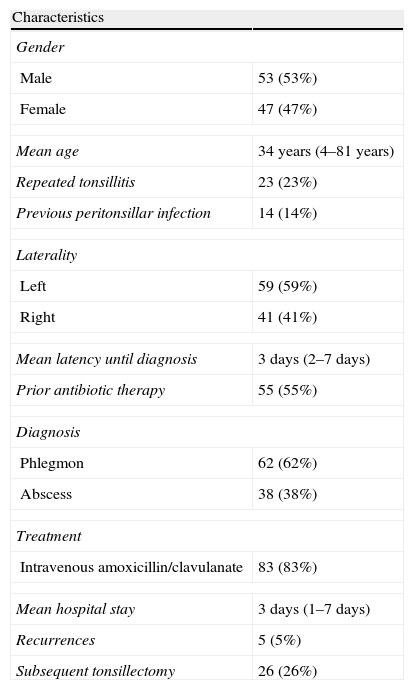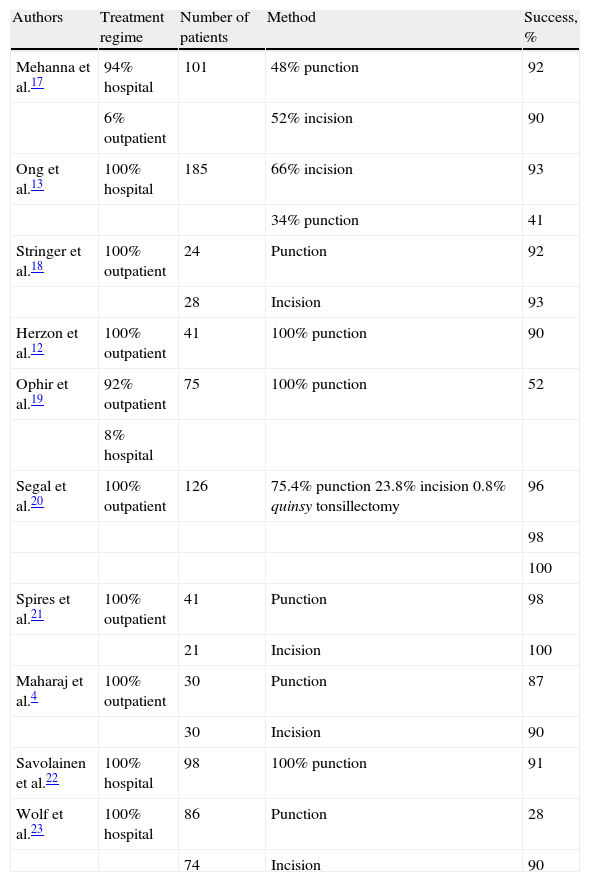Peritonsillar infection is the most frequent complication of acute tonsillitis. Peritonsillar infections are collections of purulent material, usually located between the tonsillar capsule and the superior constrictor of the pharynx. Peritonsillar infection can be divided into abscess and cellulitis.
Material and methodsWe prospectively analysed the clinical data from 100 patients with peritonsillar infection from 2008 to 2010. The diagnosis of abscess or peritonsillar cellulitis was primarily based on obtaining pus through fine-needle aspiration.
ResultsSeventy-seven percent of patients had no history of recurrent tonsillitis and 55% were receiving antibiotic treatment. Sixty-two cases were peritonsillar abscess and the rest were cellulitis. Trismus, uvular deviation and anterior pillar bulging were statistically associated with peritonsillar abscess (P<.005). All patients were admitted to hospital and treated with puncture-drainage, intravenous antibiotics (amoxicillin/clavulanate in 83% of cases) and a single dose of steroids. All patients were discharged on oral antibiotic therapy. The mean length of hospital stay was 3 days and the recurrence rate was 5%.
ConclusionsDue to the absence of clinical practice guidelines, there are different therapeutic protocols. According to our experience, puncture-aspiration and administration of intravenous antibiotics is a safe, effective way to treat these patients. To determine the efficacy and safety of outpatient management, controlled studies would be needed.
La infección periamigdalina supone la complicación más frecuente de una amigdalitis. Se define como una colección purulenta localizada entre la cápsula amigdalar y el músculo constrictor superior de la faringe. Puede clasificarse en flemón y absceso periamigdalino.
Material y métodosPresentamos un estudio prospectivo descriptivo de 100 infecciones periamigdalinas diagnosticadas entre los años 2008 y 2010. Se analizaron diversas variables clínico-epidemiológicas y el manejo de estos pacientes. El diagnóstico de flemón o absceso periamigdalino se basó fundamentalmente en la obtención de pus mediante punción-aspiración.
ResultadosEl 77% de los pacientes no tenían antecedentes de amigdalitis de repetición y el 55% estaban recibiendo tratamiento antibiótico. En el 62% de los casos se clasificó como absceso y en el 38% como flemón periamigdalino. La presencia de trismus, desviación contralateral de la úvula y el abombamiento del pilar anterior se relacionó con la presencia de absceso (p<0,001). Todos los pacientes fueron ingresados y tratados con punción-drenaje, antibioterapia intravenosa (amoxicilina/clavulánico en el 83% de los casos) y una dosis de corticoides. Al alta, todos los pacientes recibieron antibioterapia oral. La estancia media fue de 3 días y la tasa de recurrencias del 5%.
ConclusionesDebido a la ausencia de guías de práctica clínica, existen diversos protocolos terapéuticos. De acuerdo a nuestra experiencia, la punción-aspiración y la administración de antibioterapia intravenosa, es una opción segura y eficaz en el manejo de estos pacientes. Para determinar la eficacia y seguridad del manejo ambulatorio o mediante ingreso de estos pacientes, serían necesarios estudios controlados.
Artículo
Comprando el artículo el PDF del mismo podrá ser descargado
Precio 19,34 €
Comprar ahora








